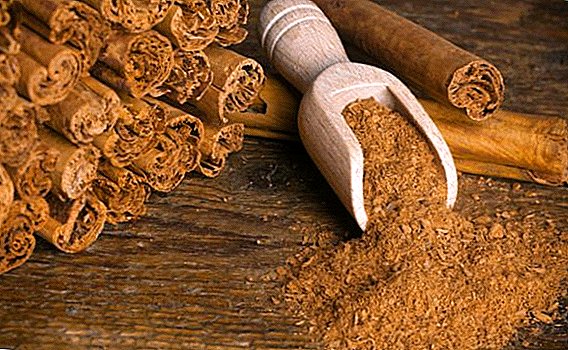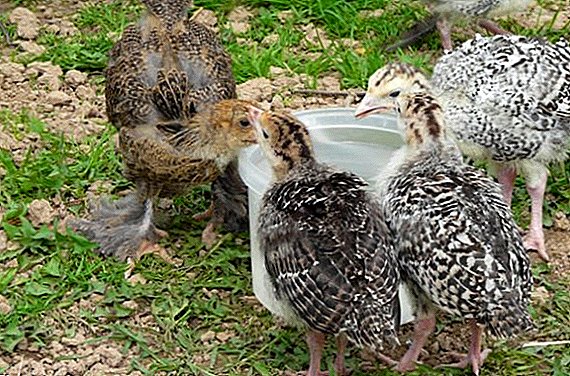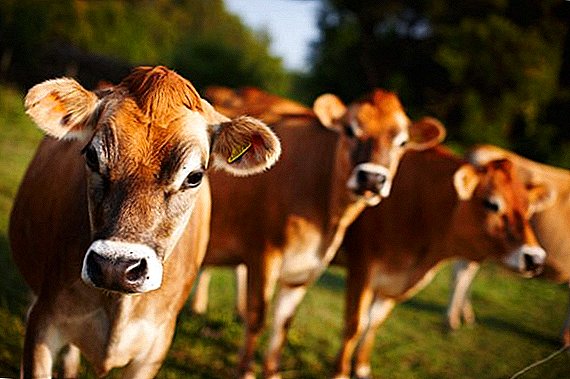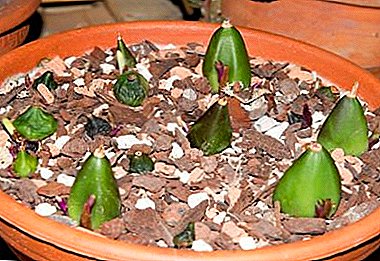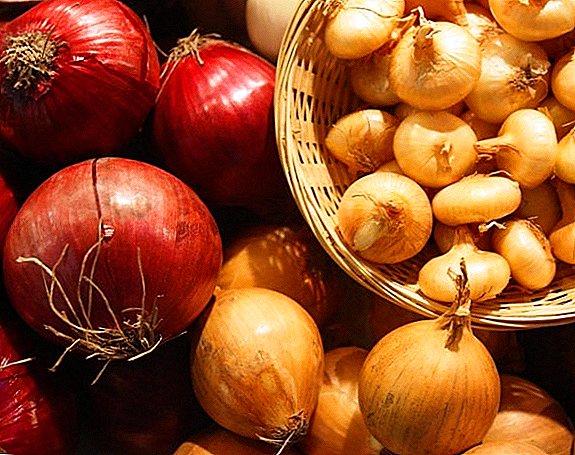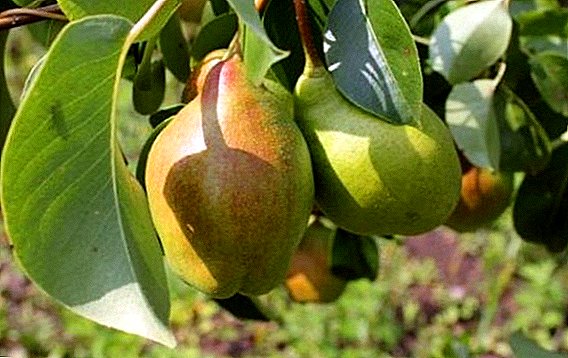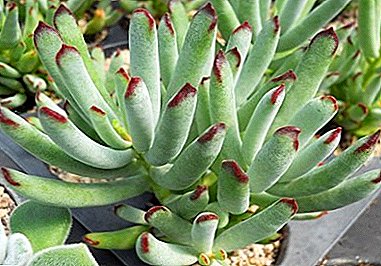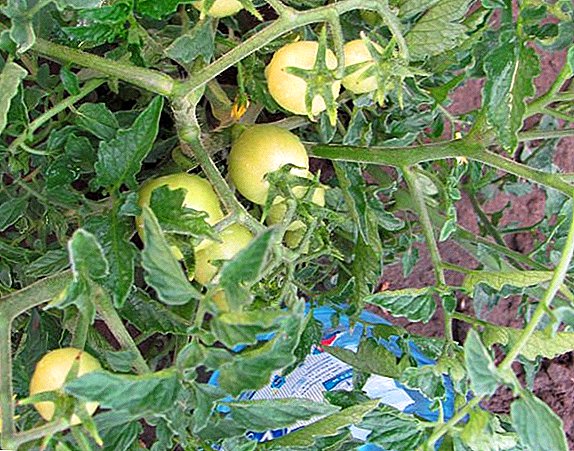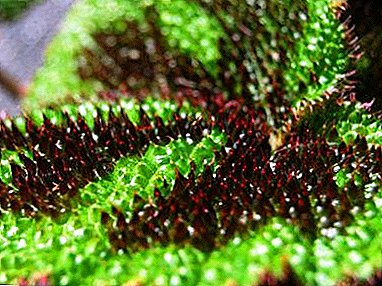
There are more than 1000 species of begonias in the world, they are common in South America, Africa, Asia, and can grow in tropical and subtropical climates and in the rocky Himalayas at an altitude of several thousand meters. In home flower beds, begonia has also long since taken its pride of place and rarely leaves indifferent floriculture enthusiasts. One of the most striking and fascinating species is considered to be Mason's begonia (lat. Begonia masoniana). In this article, we learn about the features of Mason's begonia, how to plant a plant, how to care for it, how to propagate it, and what pests can threaten it.
Botanical description and photo
Mason's Begonia - Perennial Herb with leaves of asymmetrical shape and characteristic colors.
Mason leaves have a heart-shaped form, a pronounced rough surface covered with hairs, their color can vary from golden yellow to rich green, with a silver tinge.
The length of the leaves can reach 15 cm and 17 cm wide, the height of the bush itself rarely exceeds 30 cm. The root system consists of tubers.
And this indoor plant looks like in the photo:


Features
Mason is almost impossible to confuse with other varieties of begonia, thanks to the unique pattern on the leaves, which in form can be compared with the five-fingered Maltese cross of dark green or dark brown color. Mason's begonia blossoms with inconspicuous pale green flowers that form a panicle inflorescence, and from a decorative point of view are of no value.
The life expectancy of this begonia is on average 15-20 years, but with proper care this period may increase to 25.
How to plant?
It is better to plant the plant in the spring, immediately after the dormant period is over, a special primer is suitable for this, it should be loose and well ventilated. After planting, begonia must be watered and covered with a plastic bag or a glass jar until rooting is complete - this will create the necessary greenhouse conditions. Mason well exists both in ceramic and plastic pots; for young plants, you can choose a small-sized container, subsequently increasing it with each transplant.
Before planting, the soil is recommended to be lowered into the water for several hours.so that it is completely soaked with moisture, after which give excess liquid to drain. Mason's begonia is best rooted in the wet substrate.
Lighting and location
- Mason, like most people from tropical countries, loves bright diffused light.
- Direct sunlight should be avoided, as they can cause burns on the leaves, which will cause them to wither and die.
- With insufficient natural sanctification, it can be supplemented artificially with a fluorescent lamp.
- Southeast and east windows are best for placement.
Soil selection
 What to look for. Practically in any store you can find ready-made primer for begonias, for planting Mason it is best to use it. Same peat based soil or violet soil may be suitable, which, if necessary, must be diluted with black soil.
What to look for. Practically in any store you can find ready-made primer for begonias, for planting Mason it is best to use it. Same peat based soil or violet soil may be suitable, which, if necessary, must be diluted with black soil.
If desired, the substrate for planting begonias can be prepared independently, it is necessary to mix perlite, peat and sphagnum in equal proportions. It is important to avoid excessive compaction of the soil, so that it would remain loose and get rid of excess moisture well.
Basic rules for home care
Mason does not require special care, however, it is worthwhile to pay attention to the conditions of its maintenance:
- Watering should be abundant and regular, as a rule, carried out 2 times a week as the soil dries out; it is recommended to reduce the watering intensity in winter.
- Humidity should also be high, otherwise the leaves of the begonias may begin to dry.
Important! Strongly recommended to spray begonia. Moisture on the leaves can cause decay and powdery mildew.
- Standard room temperature is optimal, when it drops to +18 in summer or +15 in winter, the plant can get hypothermia and die.
- As a top dressing, mineral fertilizers are used once a month in order not to damage the root system; it is recommended to apply fertilizer only after watering. In the period of rest from additional feeding is better to refuse.
Diseases and pests
There are a number of problems typical of Mason's begonias, and it is important to know what to look for in order to respond promptly and prevent further development of the disease.
- Drying and dying off of the leaves is usually the result of overcooling of the plant. Affected leaves must be removed and the plant moved to a warmer place, away from drafts.
- Brown streaks and spots on the leaves appear with insufficient air humidity. The best way to achieve the necessary conditions is a humidifier, you can also place a cloth moistened with water in the immediate vicinity of the plant.
- White spots on the leaves and stems is the so-called powdery mildew, at the first signs of the disease all the affected areas must be removed and the remaining plant treated with a fungicide.
 If the leaves turn yellow and wither, and then suddenly begin to darken and fall off, this is a sign of the appearance of fungus, which leads to root rot. The roots in this case become red or brownish. Begonia can be saved by removing damaged areas and transplanting into new soil. In order to avoid this disease, it is enough to observe the irrigation regime and avoid excessive soil moisture.
If the leaves turn yellow and wither, and then suddenly begin to darken and fall off, this is a sign of the appearance of fungus, which leads to root rot. The roots in this case become red or brownish. Begonia can be saved by removing damaged areas and transplanting into new soil. In order to avoid this disease, it is enough to observe the irrigation regime and avoid excessive soil moisture.- A mealybug or woolly aphid looks like fluffy whitish formations on the underside of the leaf or in the grooves. To avoid their appearance, it is enough to regularly wipe the leaves of begonia from dust.
- When the leaves curl up into tubes and become covered with dark spots, this is a sure sign of the appearance of the whitefly. This pest is spreading rapidly and is quite capable of destroying the plant. All affected areas should be removed immediately, and the remaining plant treated with special preparations (for example, "Mospilan", "Oberon" or "Admiral").
Flower reproduction
Since Mason does not seed, it can only be propagated by vegetative means.:
- with the help of leaves;
- by dividing the tubers.
Both methods are quite common and do not present any particular difficulties. Reproduction using the sheet:
- it is necessary to separate a healthy leaf together with a cutting from an adult plant;
- gently make cuts along the veins of the sheet;
- tightly press the prepared sheet to the ground, and then lightly sprinkle with soil;
- Cover the container with a plastic bag or glass jar, place in a warm well-lit place.
Important! Also begonia leaves can be germinated in water.
When breeding by dividing the tubers, you must:
 choose a tuber not less than 6-7 cm in length, the presence of buds is obligatory;
choose a tuber not less than 6-7 cm in length, the presence of buds is obligatory;- it is recommended to treat the place of the cut with ashes or crushed activated carbon;
- place the tuber in a moist soil;
- Seat the container with a plastic bag or a glass jar and place in a warm, well-lit place.
When breeding the mason begonia, the temperature should be above room temperature.. Creating a small greenhouse allows you to achieve this effect.
After the new plant is fully rooted, and new shoots have begun to appear, you can remove the protection (plastic bag or glass jar) and plant new plants in separate pots.
Mason's Begonia is a bright and at the same time not capricious plant., which will be a worthy decoration of the collection, as a novice grower, and the breeder with experience. She should pay only a little attention, and in return she will delight her owner with her unique beauty for many years.


 If the leaves turn yellow and wither, and then suddenly begin to darken and fall off, this is a sign of the appearance of fungus, which leads to root rot. The roots in this case become red or brownish. Begonia can be saved by removing damaged areas and transplanting into new soil. In order to avoid this disease, it is enough to observe the irrigation regime and avoid excessive soil moisture.
If the leaves turn yellow and wither, and then suddenly begin to darken and fall off, this is a sign of the appearance of fungus, which leads to root rot. The roots in this case become red or brownish. Begonia can be saved by removing damaged areas and transplanting into new soil. In order to avoid this disease, it is enough to observe the irrigation regime and avoid excessive soil moisture. choose a tuber not less than 6-7 cm in length, the presence of buds is obligatory;
choose a tuber not less than 6-7 cm in length, the presence of buds is obligatory;